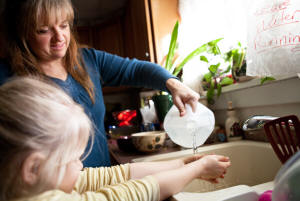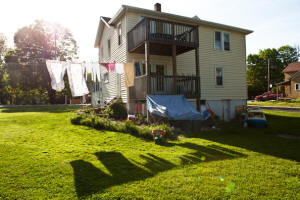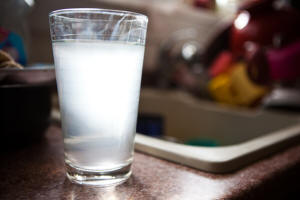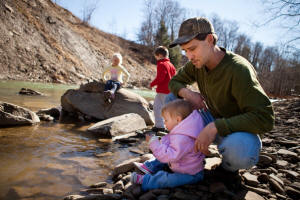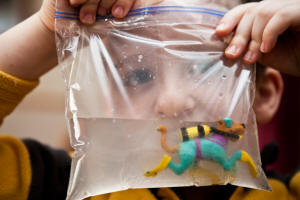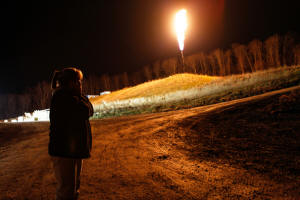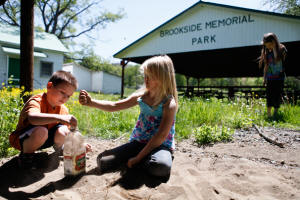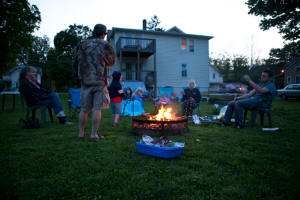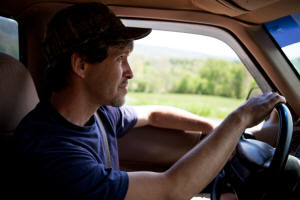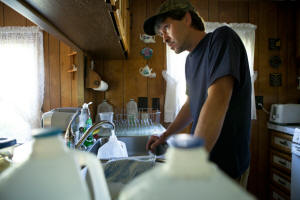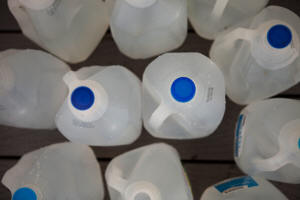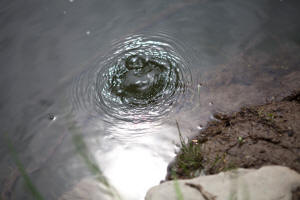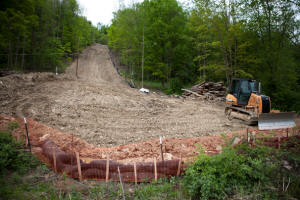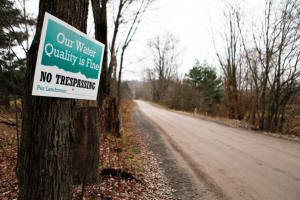A fracking boomtown, a spike in stillborn deaths and a gusher of unanswered questions
By Paul Solotaroff
June 22, 2015
NOTICE: THIS WORK MAY BE PROTECTED BY COPYRIGHT
YOU ARE REQUIRED TO READ THE COPYRIGHT NOTICE AT THIS LINK BEFORE YOU READ THE FOLLOWING WORK, THAT IS AVAILABLE SOLELY FOR PRIVATE STUDY, SCHOLARSHIP OR RESEARCH PURSUANT TO 17 U.S.C. SECTION 107 AND 108. IN THE EVENT THAT THE LIBRARY DETERMINES THAT UNLAWFUL COPYING OF THIS WORK HAS OCCURRED, THE LIBRARY HAS THE RIGHT TO BLOCK THE I.P. ADDRESS AT WHICH THE UNLAWFUL COPYING APPEARED TO HAVE OCCURRED. THANK YOU FOR RESPECTING THE RIGHTS OF COPYRIGHT OWNERS.

A midwife comes under attack after she starts asking questions about dead babies in a Utah fracking town. Photo-Illustration by Sean McCabe
Every night, Donna Young goes to bed with her pistol, a .45 Taurus Judge with laser attachment. Last fall, she says, someone stole onto her ranch to poison her livestock, or tried to; happily, her son found the d-CON wrapper and dumped all the feed from the troughs. Strangers phoned the house to wish her dead or run out of town on a rail. Local nurses and doctors went them one better, she says, warning pregnant women that Young's incompetence had killed babies and would surely kill theirs too, if given the chance.
"Before they started spreading their cheer about me, I usually had 18 to 25 clients a year, and a spotless reputation in the state," says Young, the primary midwife to service Vernal, Utah, a boom-and-bust town of 10,000 people in the heart of the fracked-gas gold rush of the Uintah Basin. A hundred and fifty miles of sparse blacktop east of Salt Lake City, Vernal has the feel of a slapdash suburb dropped randomly from outer space. Half of it is new and garishly built, the paint barely dry after a decade-long run of fresh-drilled wells and full employment. "Now, I'm down to four or five ladies, and don't know how I'll be able to feed my animals if things don't turn around quick."
Young, a fiftysomething, heart-faced woman with a story-time lilt of a voice, cuts a curious figure for a pariah. She's the mother of six, a grandmother of 14 and an object of reverence among the women she's helped, many of whom she's guided through three and four home births with blissfully short labors and zero pain meds. And the sin for which she's been punished with death threats and attacks on her reputation? Two years ago, she stumbled onto the truth that an alarming number of babies were dying in Vernal — at least 10 in 2013 alone, what seemed to her a shockingly high infant mortality rate for such a small town. That summer, she raised her hand and put the obvious question to Joe Shaffer, director of the TriCounty Health Department: Why are so many of our babies dying?
In most places, detecting a grave risk to children would inspire people to name a street for you. But in Vernal, a town literally built by oil, raising questions about the safety of fracking will brand you a traitor and a target. "Me and my kids are still cautious: If someone kicked in my front door tonight, it'd take an hour for the sheriff to get here," says Young, whose house on 60 acres is well out of town and a quarter-mile clear of her closest neighbor. "The first person they'd meet is me on the staircase, pointing that .45 dead at 'em. And I know how to use these things — I can nail a coyote in the pasture from 100 yards."
Prodded by Young and the concerns she pushed along, which made their way through channels to state officials, TriCounty Health announced a study in 2014 to assess Young's concerns over the infant mortality rate. But Young, backed up by experts in Salt Lake City, believed the study was designed to fail. She says that any serious inquiry would have started with Suspect One: the extraordinary levels of wintertime pollution plaguing the Basin since the vast new undertaking to frack the region's shale filled the air with toxins. The county merely counted up infant deaths and brushed aside the facts about Vernal air pollution: ozone readings that rivaled the worst days of summer in New York, Los Angeles or Salt Lake City; particulate matter as bad as Mexico City; and ground air fraught with carcinogenic gases like benzene, rogue emissions from oil and gas drilling. Indeed, pollution was so bad in this rural bowl that it broke new ground in climate science. For decades, experts believed that life-threatening smog occurred only in or near big cities. But the Basin, which is bound on all four sides by mountains, is a perfectly formed bowl for winter inversions, in which 20-below weather clamps down on the valley and is sealed there by warmer air above it. During those spells, when the haze is visible and the air in one's lungs is a cold chisel, the sun's rays reflect off the snow on the ground and cook the volatile gases into ozone. The worst such period in the Basin's recent history was the winter of 2012-13, when nearly all the Uintah mothers whose babies died were pregnant.
Other key information was available to TriCounty, including multiple recent studies that link mothers' exposure to toxic air with fetal disasters of all kinds, including stillbirths, birth defects and developmental syndromes. But four months after he announced the study, Shaffer retired as TriCounty's chief; six months later, the department's findings were released. The deaths were deemed "not statistically insignificant," Sam LeFevre, an epidemiologist with the Utah State Health Department who conducted the study for TriCounty, told an assembly of concerned Vernal citizens. When pressed on possible causes for the deaths, he suggested the health problems of mothers, citing smoking, diabetes and prenatal neglect among the Basin's residents. LeFevre made it clear he was sympathetic to the crowd's concerns. "I know what it's like to lose a pregnancy," he announced. "My wife's had eight, and only four live births."
Which raises a question you might ask in a state whose legislature is so rabid for oil and gas money that it set aside millions to sue the federal government for the right to drill near Moab and Desolation Canyon, some of the state's most sacrosanct places: How many dead infants does it take before you'll accept that there's a problem?
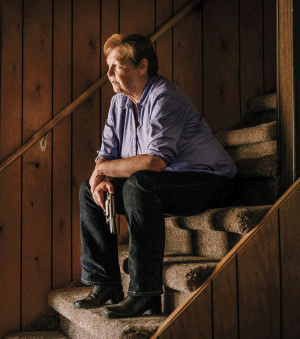
After Young spoke to the media about the infant deaths, she received threats and now goes to bed with her .45 by her side. Photograph by Michael Friberg
In January 2001, days after taking office as the 43rd president of the United States, George W. Bush convened a closed-door task force to confront the country's addiction to foreign oil. Since the early 1970s, American motorists (and administrations) had ridden the loop-de-loop of peak demand: shortages, price spikes and the market manipulations of OPEC's billionaire princes. Two-thirds of the crude being refined here for gas arrived on overseas freighters, and the industry's bids for new offshore formations were blocked by an executive order from Bush's father. A bold plan was called for, including "environmentally sound production of energy for the future." Or so went the rhetoric in the announcement that heralded the group's formation. But Bush named Dick Cheney, the former CEO of Halliburton, to lead the effort — "Can't think of a better man to run it," he said — and any hope for a rational, climate-sparing program went up in a flare of hydrocarbons.
The vice president sat down with supplicants from the fossil-fuel sector and gold-star donors to his campaign. For months, he or his small staff met in secret with the likes of James Rouse, the then-vice president of Exxon Mobil Corp.; Enron's Kenneth Lay; Red Cavaney, the then-president of the American Petroleum Institute; and dozens of lobbyists and senior executives from the coal, mining, electric and nuclear sectors. What Cheney sent the president, four months later, was a policy essentially written by the barons themselves: a massive expansion of domestic drilling on federally owned lands; tens of billions of dollars in annual subsidies to Big Oil; and wholesale exemptions to oil-and-gas firms from environmental laws and oversight. In essence, Cheney's program turned the Department of the Interior into a boiler-room broker for Big Oil, and undercut the power of the Environmental Protection Agency.
Cheney's plan was such a transparent coup for Big Oil that it took four years, two elections and the Republican capture of both houses of Congress to make it to Bush's desk as legislation. Along the way, the bill gained a crucial addendum, known today as the "Halliburton loophole": a carte-blanche exemption from the Safe Drinking Water Act for an emergent technique called fracking. A form of extraction dating back to the Civil War, when miners used nitroglycerin to blow holes in oil-soaked caves (a subsequent version, in the 1960s, used subterranean nukes to fracture rock), fracking has since evolved into a brute but nimble method for blasting oil and gas deposits that couldn't be recovered by conventional derricks, at least not at a rate that made them profitable.
The process, perfected and marketed by Halliburton, shoots huge amounts of fluid at very high pressure down a mile or more of pipe to break the rock. That fluid, a trademarked secret called "slickwater" that has toxic solvents, is mixed with a million gallons of water, roughly a fifth of which come barreling back as wastewater. It's a desperately dirty job, marked by horrors of all kinds: blowouts of oil wells near houses and farms; badly managed gas wells flaring uncapped methane, one of the planet's most climate-wrecking pollutants.
Then there's pollution of the eight-wheeled sort: untold truck trips to service each fracking site. Per a recent report from Colorado, it takes 1,400 truck trips just to frack a well — and many hundreds more to haul the wastewater away and dump it into evaporation ponds. That's a lot of diesel soot per cubic foot of gas, all in the name of a "cleaner-burning" fuel, which is how the industry is labeling natural gas.
"Fracking moved the oil patch to people's backyards, significantly increasing the pollution they breathed in small towns," says Amy Mall, a senior policy analyst for the Natural Resources Defense Council. "Basically, it industrialized rural regions, and brought them many of the related health problems we were used to seeing in cities."
Mall, who had just moved to Colorado when the frack rigs arrived, en masse, in 2006, soon began hearing anguished reports from communities overwhelmed by dirt and fumes. At first, it was all direct-symptom stuff: bloody noses, coughs and rashes, migraine headaches and such. Eventually, though, worse news came from Garfield County, where gas drilling exploded, figuratively and otherwise, in the rural western slope of the state. Residents with cancers and neurological disorders; people passing out from exposure to chemical leaks; wells that blew out and would burn all day, while more than 100 million cubic feet of gas leaked into Divide Creek, which flows to the Colorado River. "It's the long-haul exposure that nails you — I watched people get progressively sicker," says filmmaker Debra Anderson, who shot a documentary in Garfield County that recorded the devastation of towns with names like Silt and Rifle; her film Split Estate won an Emmy and became essential viewing in Ohio, West Virginia and Pennsylvania, as the frackers moved east. "As soon as it aired, we were deluged with calls from communities," she says. "Same story, same symptoms, different town."
Workers found dead atop separator tanks from exposure to wastewater fumes. Cows birthing stillborn calves on ranches near well-pad clusters. Children with cancers — leukemia, lymphoma — in places with no known clusters. "For a while, all we had were anecdotal reports, which the industry bashed as 'bad science,' " says Miriam Rotkin-Ellman, a senior health scientist for the NRDC. "But in the past few years, there's been a torrent of studies finding worrisome air pollution stemming from oil and gas sites. The impacts of this pollution are regional, not just local, meaning it can make you really sick from miles away," and that the people most susceptible to its toxic effects are the ones at either end of the life spectrum: "fetuses and the elderly."
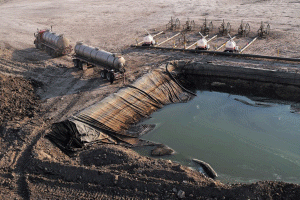
Fracking operations truck their liquid refuse to evaporation ponds, where it dissipates into the air. Marc Silver/The Filmmaker Fund
In some of these communities, leaders came forward to seek help and information from county officials. What came back, over and over, though, was ringing silence, as health-department representatives shrugged and hung up. "In Karnes County alone, we had two blowouts last week, one that covered everything in a coat of oil and methane, including people's homes and livestock," says Sharon Wilson, the state organizer in Texas for a national nonprofit called Earthworks, which helps small communities, like Karnes City in southeast Texas, fight back against billionaire drillers. In another disaster, a well leaked methane for days, but when Wilson called the Texas Commission on Environmental Quality, she was told that they wouldn't send an inspector because she didn't "live in the area." "I told him I was only calling because the residents there tried to, but couldn't get a response from him." (A spokeswoman for TCEQ told Rolling Stone that since "Ms. Wilson is not a resident [of Karnes County], she has limited ability to document nuisance conditions," adding that they'd previously conducted investigations in the area.) Karnes is a poor and sparsely inhabited place, but even inlying suburbs of Dallas – towns like Denton and Irving and Arlington — are quickly discovering how little recourse they have once the frackers come to town. The new governor, Gregg Abbot, signed a bill that quashed the rights of municipalities to ban fracking within their boundaries, after Denton's townspeople voted thunderously to do so. That freed that town's drillers to go back about their business — digging wells across the street from preschools and hospitals, and snaking gas pipes around people's houses. "State governments have fallen down on protecting the public," says Sharon Buccino, a senior lawyer for the NRDC. "The upshot is that towns have lost control of their future. They no longer have a say in what happens there."
Except for the rare leaders who have said no to frackers — New York Gov. Andrew Cuomo, Vermont Gov. Peter Shumlin — Big Gas has been on a 10-year joyride unlike any in American annals. There are now more than 1 million active oil and gas wells in the country, and our oil companies posted profits of $600 billion during the Bush years. President Obama, who promised to cap and trade emissions while building out America's post-oil future, instead has presided over the breakneck expansion of fossil-fuel drilling. Under his watch, U.S. production has risen each year — up 35 percent for oil, 18 percent for gas — and enabled the country to barge past the Saudis as the world's lead producer of oil and gas. (He also broke his word to end tax cuts for oilmen; those subsidies are up nearly 50 percent since he took office.)
Whatever Cheney's doing now, he must look upon his handiwork and smile. OPEC has lost its whip hand over oil prices, SUVs are selling off the lot again, and Obama takes victory laps because we now produce more oil than we import. Glad tidings for all – except the people in more than 30 states who wake up to the thump of fracking rigs. To them, the message from Washington has been tacit but final: You folks are on your own out there.
It was never Donna Young's plan to raise a racket about fracking. She grew up around coal mines and bears no brief against the grunts who work the rigs and the men who own them. "I've got one son commuting to North Dakota" to work a rig and "another who's done every job there is, from tearing down the rigs, putting them on flatbeds and driving 'em clear back from Kansas," she says. "I believe we can live with drilling — as long as the politicians make sure it's done responsibly."
But then, nothing in Young's life has gone to plan — not that she minds the left turns. The impulse to become a midwife at 39, then move back to Utah nine years later so she could help her ailing father run his ranch — it's all been improvised and guided by feel. She was born in Moab to a Mormon family, raised around horses and miners and men on old tractors who came home reeking of cow shit. Her father was a range rider for the Bureau of Land Management who bred and trained racehorses on the side. When he retired to Idaho, Young joined her folks there and opened a health-food store. A mother of two, she earned a degree in naturopathy, then found her true vocation, birthing babies. "I'd been working with lots of people, some cancer patients and chronically sick people, and here were these clients who had a clean slate — or would have, if their moms had ate healthy. I thought, 'Oh, this is what I'm put here to do. Bring 'em into the world with no drugs or toxins, then teach the moms to raise them that way.' "
She put together a method that was two parts nutrition to one part personal trainer. "From the git-go, my girls give up flour, milk, sugar, soda, caffeine and anything microwaved — and they know I'll urine-test them to check." They exercise for at least an hour each day and do floor work to bring the baby's head down to the proper position for birthing. "I don't have patients, I have athletes — and you should see the kids that come from them."
After 20 years and hundreds of births, Young has every reason to be proud. But in the fall of 2013, her client Caren Moon was pregnant with her third child and not doing well in the first trimester. She was cramping a lot and feeling weak; Young ordered bed rest and a natural progesterone cream to help with the bouts of mild bleeding. Moon was up on her feet again shortly, chasing after her toddlers, both birthed by Young. Then, the week before Thanksgiving, an early snowstorm led in a cold-air inversion. Moon felt ill again, took to bed, and lost the pregnancy while her house was filled with holiday guests. "It was right in that period of heavy ozone," Moon says. "I thought we'd taken all the precautions."
The Moons live on Bonanza Highway, a major conduit between Vernal and the oil fields due south. All day and into the night, massive trucks barreled by, farting CO and diesel soot that hung over the yard like clouds of no-see-ums. Five minutes east, her friend Melissa Morgan was also struggling to keep her baby. "I got pregnant about the same time Caren did, and was sick with all the stuff that she had — bleeding, cramping, feeling bad when I went out," says Morgan. "There was a horrible, thick haze hanging around here for weeks. You could see it when you drove up the mountain and looked back at just this blanket of gray . . . yuck."
Morgan spent weeks on bed rest while women from her church cooked and looked after her kids. The baby, her fifth, somehow made it to term, but weighed nearly a third less than her previous four and was in and out of doctors' offices until she was eight months old. "It's a miracle she's here at all," says Morgan. "When I saw the placenta, it was small and deformed, like it had used up all its tissue to protect her."
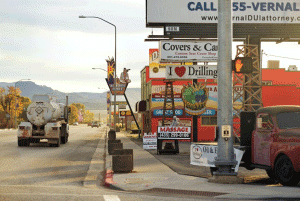
In the past decade, Vernal, Utah, has been a fracking boomtown. R.J. Sangosti/The Denver Post/Getty
I heard some version of that tale all over town. Avery Lawton, a radiant redhead, was pregnant that winter with her second child, but the fetus wasn't growing. It was so frail at 30 weeks that an obstetrician told her it could die during labor, and she should deliver at the hospital and not at home. Defying him, she went for a second, and third, opinion; her daughter, almost two now, was born with a rare and profound vision disorder, for which she wears Coke-bottle goggles.
In all the years Young has delivered babies, she says this was her first with a birth defect — and four more followed in 15 months. A girl with a shredded epiglottis, choking her when she tried to feed; a boy born tongue-tied and with a clubfoot; a girl born tongue-tied and lip-tied as well, preventing her from latching onto her mother's breast. All required surgeries days after birth. Still others were born tiny or with mangled placentas — but at least they were alive and intact.
In May 2013, Young delivered a girl who was pink and fully formed; the child never took her first breath. She came out of her mother and collapsed in her arms; Young performed CPR, then raced her to the Ashley Regional Medical Center while the mother remained at home. She called 911 on the way, and a uniformed officer escorted her into the emergency room. Efforts to revive the child proved useless, however, and Young, who was heartsick and staggered by the loss, decided to join the mother at home. But a staffer, Young claims, wouldn't let her leave the building. She says he put Young and her daughter Holt, a 15-year-old who often accompanies her during the births, in a room. ("We did not prevent Ms. Young from leaving our hospital," a spokeswoman for ARMC said via e-mail. "Police onsite who were gathering information may have, but no one from our hospital was involved in that.") After an hour, Young says, she was let go at the insistence of the dead infant's father. She got home at 5 a.m. and wept and paced her bedroom well past sunup.
At 10 a.m. that day, a detective drove out and interrogated Young. She explained how a typical home birth happens and took him through the evening step by step. At the end, he concluded she'd done nothing wrong and declared the matter closed from his end. Devastated, she joined the bereaved parents at the graveside that week. There, at Rock Point Cemetery in Vernal, an acquaintance pulled her aside and whispered, "This isn't the only baby to die this year." She led Young to a pair of fresh-dug graves; two newborns had been laid to rest there since the first of the year. Young went home and combed through online obits: four other babies from Vernal or close by had died already that year. It was a shockingly big number for a small town.
Then she plotted the coordinates of the dead, and another bolt went through her. Three of the babies, including the one she'd just lost, were from moms who lived or worked near the intersection of 500 West and 500 South, a four-way stop sign that bottlenecks traffic and forces big-rig drivers to brake-start-brake, which drapes the block in shrouds of hydrocarbons. "Looking back, there were red flags," says Young. "Every time I'd visit for a checkup, I'd come back with a splitting headache and my eyes and nose running."
Five more babies would die that year, bringing the body count to at least 10 in Vernal; three more were lost in towns nearby. Young searched back to the start of the decade. In 2010, there were two, about average for a small town, then one in 2011 and four in 2012, including one whose mom worked at the senior facility on that smog-bound corner. And then the big jump in 2013, on the heels of a historic run in production that began a decade earlier. The Uintah Basin alone was home to more than 11,000 wells – that's an enormous concentration of soot and volatile organic compounds (VOCs) drifting into Vernal, then sitting there; in that inversion-filled winter, the VOC count was equivalent to 100 million cars' exhaust. Reached for comment about the region's pollution, Kathleen Sgamma, vice president of public affairs at the Western Energy Alliance, a trade association for the drillers, said, "We acknowledged that the emissions were our responsibility, [and] have worked with the state to reduce them." Asked about a link between those toxins and infant deaths, Sgamma said that "the epidemiologist showed there was not enough data to find the cause, and to make the jump you're making is not supported."
By June 2013, Young had seen enough. Accompanied by Bo Hunter, her 23-year-old son, she paid a call on Joe Shaffer, the TriCounty health director. She didn't know these mothers or their medical histories — so had no idea what was killing their babies — and acknowledges that the cause may never be determined. But she was acutely fearful for her other clients' babies and wanted Shaffer's advice on keeping them safe. She and Hunter say she'd barely broached the subject of infant losses when Shaffer admitted he too had concerns about the air quality in Vernal and the effect it might have on area families, including his own. (Shaffer, who retired in the summer of 2014 and hasn't spoken publicly since he left, was reached by phone at his home but declined to comment.)
Frantic now, Young called a local advocacy group, who connected her with Dr. Brian Moench. Moench, an anesthesiologist in Salt Lake City who co-founded Utah Physicians for a Healthy Environment, is a cross between Bill Nye and Bill McKibben, a science-geek activist and erudite spokesman for a growing clean-air coalition. With the roughly 350 doctors in Utah he's recruited to the cause, he and his colleagues gathered dozens of studies about pollution and its long- and short-term damage to the unborn. "What we know now," he says, "from several blue-ribbon studies, is that the chemicals Mom inhales in industrial zones are passed to her baby through the umbilical cord, exposing them to many complications. We also know these toxins like to live in fat cells — and the brain is the largest fat reservoir in a developing fetus." At Moench's urging, Young ordered her clients to stay in on bad air-quality days, and to equip their homes with high-end filters that trapped both soot and gases. Finally, in May 2014, LeFevre, the state health official, met with the TriCounty Health Department to present his proposed method to study the deaths. It would not, however, look at environmental factors; this was strictly about the statistical significance of the infant deaths. That might have been the end of it if not for Moench. He looped in a contact at The Salt Lake Tribune, who sent a writer down to cover the announcement. For the next two days, the Tribune ran page-one stories about Young's efforts to learn the truth about those deaths.

Dr. Moench says fracking pollution may be to blame for the stillborns. Marc Silver/The Filmmaker Fund
That's when some people in Vernal started to turn on Donna Young. The phone calls went on for months. Several times a week she'd pick up the phone to snarling curses and personal accusations that she was "trying to bust up the economy." Staffers at Ashley Regional Medical Center trashed her to clients, she says, and denounced her in online comments as a baby killer. (The ARMC spokeswoman denies this, adding that "if anyone employed by our facility said this, it was not on behalf of our hospital.") Ben Cluff, its CEO, threatened Young with legal action for "[communicating] inaccurate information regarding the number of infant deaths at our facility." When Young took Avery Lawton for an ultrasound there, both women recall that a staffer told Young that everyone was out to destroy her, "and it's political."
It's sad but unsurprising that Young would get pushback from a town that leans on oil as much as Vernal. Since crude was first pumped in this High Plains town shortly after World War II, its fortunes have tracked the price point of gas, riding its fluctuations up and down. Then along came the fracking boom, which extracted fossil fuels at rates undreamt of 10 years back, and Vernal was suddenly awash in real money. Virtually the whole west side is newly constructed, with big-box chain stores, midrange hotels and three brewpubs serving the roughnecks who rent the prefab townhomes. Oil money helped fund the new City Hall, as well as the 32-acre convention center, one of the largest such spreads in the West. There's the juice bar hawking T-shirts that say 'I Heart Drilling,' the July 4th parade featuring girls on derrick floats and the yearly golf tourney called Petroleum Days.
So it's moot to expect much Green Party ferment from a place where boys quit high school in boom years to work the rigs at 16. But where are all the worried parents? "A huge number of my kids have breathing problems — it averages six or seven in every class," says Rodd Repsher, a health teacher at Uintah High who hails from Pennsylvania. "Come January, they're out sick for a week at a time. I never saw anything like it back home," says another teacher, who relocated from the Northeast.
I met the two teachers at a town-hall forum led by Moench and three of his colleagues from Salt Lake City. Though they'd papered the town with fliers about the forum — a primer on pollution and ways to protect your family from it — and invited the mayor, Sonya Nelson, and the three Uintah County commissioners, only 40 people showed up at the Vernal Junior High School auditorium. Several were Young's clients and their husbands and kids. Young was there, too, along with her daughter Holt. As a precaution, she'd brought a bodyguard.
In an easy-to-follow slide show about the air in the Basin and its calamitous level of pollution, Moench and his fellow doctors, two of them obstetricians, spent an hour and a half building a brick-by-brick indictment against the effect of those toxins on fetal neurons. "Think of them as bullets to developing brain cells," said Moench. "They either kill some of those cells, alter them or switch them off, blocking their connections to other cells." Citing a wave of new studies that link inhaled contaminants to everything from diabetes and obesity to ADD, he added that babies "are being born now pre-polluted. Lower IQs, less serotonin, less white-brain matter: We're literally changing who they are as human beings."
As Moench spoke, I heard grunts and impatient stirring from a plump man sitting behind me. He introduced himself to me as Bill Stringer, one of the three Uintah County commissioners. In the 10 years before he took office in 2014, Stringer ran the Vernal branch of the Bureau of Land Management. Under him, the outpost grew from a single-story affair to one of the busiest licensing offices in the country. Stringer and his staff approved nearly three times the number of permits per year as his predecessor did. They granted "every application put before them," says Stan Olmstead, an inspector for the BLM who quit in disgust under Stringer. "We couldn't do site inspections; anyone with integrity up and left." (Stringer tells Rolling Stone Olmstead has it wrong. He says his office performed the inspections required by law, and that Olmstead, an environmental inspector in the field, had no direct knowledge of permits granted or rejected by the Vernal office. When pressed, however, Stringer could cite no example of a permit being denied to area drillers.) According to The New York Times, Stringer's office worked to quash a government study of the impact of drilling on Vernal's air. He fought, instead, for an industry-backed assay, which found "no unacceptable effects on human health." That was in 2009; months later, the Basin posted horrifically high readings of ozone and CO.
Asked what he'd thought of the doctors' presentation, Stringer dismissed it as "apples-to-oranges" science. "We have much more reliable research in town," he says, naming two environmental scientists at the local campus of Utah State University. When pressed for details about their findings, he turned to leave. Seth Lyman and Marc Mansfield, the scientists Stringer mentioned, agreed to talk about their ongoing study of air quality in the Basin. They concede that the region has an ozone problem, particularly near the gas fields in the low-elevation areas south of town, and agree that there have been established health risks associated with this contamination, such as low birth weights and an increase in asthma symptoms. However, they question its impact on stillbirths in Vernal, noting that in 2010 and 2011 there were many high-ozone days, without a significant jump in dead infants. "Ozone here is a long-term problem, and a lot of work has to be done," says Lyman. "But a lot of smart people here are working on solutions."
Fortified by those tidings, I drove out to inspect a massive evaporation pond 12 minutes west of town, accompanied by Moench and his associate Tim Wagner, the executive director of Utah Physicians for a Healthy Environment, who'd brought air-testing canisters to measure emissions. When water bolts back to the surface after fracking, it's laced with gases and salts and chemical waste, and it has to be trucked, in the hundreds of thousands of gallons, to disposal sites. There, the fluid sits and dissipates, the sediment sinking as the water thins — a process sometimes assisted by giant misters — until nothing is left but a bog-thick sludge, which is scooped up and trucked to landfills. If the pond dries slower than the company receives waste, they simply dig a new one beside it.
Then once that pond fills, they dig another, then another, and another, and so on. Seen from the air, these waste ponds resemble a kid's watercolor tray, though the water turns shades not seen in any paint tube: Imagine melanoma as a liquid. Generally, the ponds are set back hundreds of yards from the desert roads, but their stench wedges into your car's interior no matter how tightly it's sealed. On the several occasions I drove to Young's place, I was sickened by the fumes of a pit en route.
Across the country, there have been disastrous spills of wastewater into rivers and streams, and illegal dumping in an aquifer. Last winter, millions of gallons polluted Yellowstone River, dumped from leaky pipes in North Dakota. Untold gallons from evap ponds have fouled streams and springs in Pennsylvania; that state recorded 53 spills in 2014 alone, and fined one offender, Range Resources, more than $4 million. These aren't small runoffs that seep through soil and spit fire from some ranch hand's spigot. These are industrial crimes that can potentially taint the drinking water for millions of people downstream.
Stunningly, though, the feds gave the industry a pass when, this June, a five-year EPA study found no systemic contamination of drinking-water sources by slickwater fluids used in fracking. But in the next breath, it cited case after case where precisely that had happened, then said it couldn't gauge the frequency of such events because the industry hadn't furnished essential data: the quality of the water before they started fracking. The result: Activists and industry both claimed victory, and the EPA called for more study.
It was with a healthy dram of fear, then, that I took the red-dirt road to the La Point Recycle and Storage pond. We hiked up a half-mile path from our car, stepping over cow shit and shed deer antlers. We smelled the pond well before we reached the rise: a molten stench that stabbed the back of our noses and burned our eyes bloodshot on contact. A cyclone fence surrounded the pit, but the gate at the north end was unlocked and unmanned. (La Point declined to comment for this story.) Holding jackets over our mouths, we crept across the deck so that Moench could hook a particle counter to the fence. The air now was a shock wave of solvents that sent us scrambling for higher ground above the pit. Looking down from our perch on a sandy bluff, we saw the evap pond in its immensity: a green-black sheet so thick with sludge its surface didn't ripple in the breeze.
"The solvents you're smelling, they can travel for miles — and there were about 50 of these pits at the height of the boom," said Wagner.
I did a quick accounting in my head: a half-million gallons of waste from each of thousands of wells, either hauled to ponds like this or pumped to underground pits. Add to that more than 2,000 wells that have been granted but not drilled yet — nearly all of them approved by the Vernal field office. Where will all that poison go, and who will still be here to breathe and drink it?
A couple of weeks later, Young called me with horrible news: "Four of my five ladies lost their babies. Four miscarriages in just two weeks! How'm I s'posed to do this anymore?"
I asked her what she thought might have caused this spate of losses. "They all live in town and said their water tasted bad, so I went to their houses and took samples." She tested the water with a monitoring device used by drillers; most of the batches tested were positive for extreme toxicity from hydrogen sulfide, H2S, one of the most deadly of the gases released by drilling. Exposure to it has killed a number of rig workers over the past few decades. In high enough concentration, just one breath is enough. In much smaller amounts, H2S can cause miscarriages — and the amounts Young says she found were more than 7,000 times the EPA threshold for safety.
"I know I have to call somebody, but who?" Young says. "Who is there to trust in this town?"


